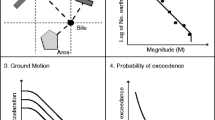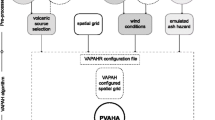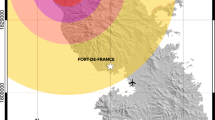Abstract
In a companion paper (this volume), the authors propose a methodology for assessing ash fall hazard on a regional scale. In this study, the methodology is applied to the Asia-Pacific region, determining the hazard from 190 volcanoes to over one million square kilometre of urban area. Ash fall hazard is quantified for each square kilometre grid cell of urban area in terms of the annual exceedance probability (AEP), and its inverse, the average recurrence interval (ARI), for ash falls exceeding 1, 10 and 100 mm. A surrogate risk variable, the Population-Weighted Hazard Score: the product of AEP and population density, approximates the relative risk for each grid cell. Within the Asia-Pacific region, urban areas in Indonesia are found to have the highest levels of hazard and risk, while Australia has the lowest. A clear demarcation emerges between the hazard in countries close to and farther from major subduction plate boundaries, with the latter having ARIs at least 2 orders of magnitude longer for the same thickness thresholds. Countries with no volcanoes, such as North Korea and Malaysia, also face ash falls from volcanoes in neighbouring countries. Ash falls exceeding 1 mm are expected to affect more than one million people living in urban areas within the study region; in Indonesia, Japan and the Philippines, this situation could occur with ARIs less than 40 years.










Similar content being viewed by others
References
Baxter PJ (1990) Medical effects of volcanic eruptions. Bull Volcanol 52(7):532–544
Blong RJ (1984) Volcanic hazards: a sourcebook on the effects of eruptions. Academic, Australia, pp 1–424
Chen Y, Liu J, Chen L, Chen Q, Chan LS (1998) Global seismic hazard assessment based on area source model and seismicity data. Nat Hazards 17(3):251–267
Francis P, Oppenheimer C (2004) Volcanoes. Oxford University Press, Oxford, pp 1–521
GNS Science (2006) Impacts of ash falls. Volcanic hazards in New Zealand.
Hurst AW (1994) ASHFALL, a computer program for estimating volcanic ash fallout: report and users guide. Institute of Geological & Nuclear Sciences Science Report 94
Jenkins S, Magill C, McAneney J, Blong R (2012) Regional ash fall hazard I: a probabilistic assessment methodology. Bull Volcanol (this volume)
Newhall CG, Self S (1982) The volcanic explosivity index (VEI)—an estimate of explosive magnitude for historical volcanism. J Geophys Res 87:1231–1238
Oak Ridge National Laboratory (2005) LandScanTM Global Population Database.
Siebert L, Simkin T (2002–) Volcanoes of the world: an illustrated catalog of holocene volcanoes and their eruptions. Smithsonian Institution, Global Volcanism Program digital information series, GVP-3. (http://www.volcano.si.edu/info/about/about_votw.cfm#CitationGuidelines).
Simkin T, Siebert L (1994) Volcanoes of the world. Geoscience Press, Tucson, pp 1–349
Small C, Naumann T (2001) The global distribution of human population and recent volcanism. Global Env Change Part B: Env Hazards 3(3–4):93–109
UN/ISDR (2002) Living with Risk: a global review of disaster reduction initiatives. United Nations/International Strategy for Disaster Reduction, Geneva
United Nations Statistics Division (2007) World urbanization prospects: the 2007 revision population database.
Acknowledgments
The authors would like to thank Lee Siebert (Smithsonian Institution) for providing unpublished data and for helpful discussions regarding volcano type categorisation and Tony Hurst (GNS Science) for the ASHFALL source code. We also sincerely thank Costanza Bonadonna and Warner Marzocchi for providing detailed and very valuable reviews of the manuscripts and the editors of Bulletin of Volcanology for their support. This research was carried out while Susanna Jenkins was holding an International Macquarie University Research Scholarship.
Author information
Authors and Affiliations
Corresponding author
Additional information
Editorial responsibility: J.C. Phillips
Appendix 1: Definition of acronyms
Appendix 1: Definition of acronyms
AEP | Annual exceedance probability |
ARI | Average recurrence interval—approximate inverse of annual exceedance probability |
ASHFALL | Semi-analytical two-dimensional ash dispersion model developed by GNS Science, New Zealand |
PD | Population density per square kilometre |
PWHS | Population-weighted hazard score: the product of AEP and PD |
VEI | Volcanic explosivity index |
Rights and permissions
About this article
Cite this article
Jenkins, S., McAneney, J., Magill, C. et al. Regional ash fall hazard II: Asia-Pacific modelling results and implications. Bull Volcanol 74, 1713–1727 (2012). https://doi.org/10.1007/s00445-012-0628-7
Received:
Accepted:
Published:
Issue Date:
DOI: https://doi.org/10.1007/s00445-012-0628-7




